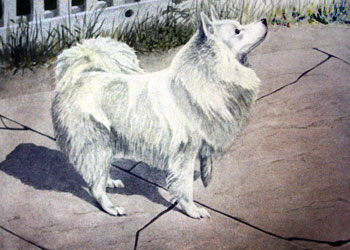Dog Breeds
Dog Tips
Training
Exercise
Medical
Interviews
Miscellaneous
About DB
Contact DB
Resources

Illustration by Louis Agassiz Fuertes
Spitz
The “wolf spitz” of the mid-Victorian fancier is now seldom seen in this country; yet he is a very interesting dog, having much to do in the gradual evolution of many types popular today. Almost unaltered except in size, he see him now as the popular toy Pomeranian; his influence is easily seen in the saucy black schipperke; there is little doubt that he has a share in the varies shepherd dogs of central Europe, and one can see strong probability that this strain reappears in the fine dogs of the North, represented by the Samoyed and sled dogs of the Eastern and the Eskimos of the Western hemispheres, though it is not clear how it got there.
The true spitz is a dog weighing about 25 to 30 pounds, and the best dogs are white or cream-color, though fawn, brown, and even black dogs are found. The mixture of white in patches with any of these “self” colors is an unpardonable defect with the fancy. They are bright, fascinating, pretty dogs; but it must in candor be said they are very “choicy” in making friends and very ready to repel with sharp teeth any unwelcome advances by dogs or humans they don’t know. They are apt to be a real responsibility to the owner on this account.
The Eskimo dog, Samoyed, Spitz and Chow-Chom, although differing in size and sometimes in color, probably had a common origin. Their dense coats show that they all properly belong in the North, and their straight, upright ears and general appearance betray their blood relationship to the wolf.
The spitz, usually solid white or solid black, has long been a favorite in Germany. Thirty or forty years ago it was popular in this country, but it is a dog of uncertain temper, and that may be one reason why it is no longer in favor, except in a reduced for as a toy dog.
Did you enjoy this article? Let us know what you think by commenting below. Don't forget to Friend us on facebook and subscribe to our twitter feed to stay updated! Thanks for reading, recommend us to your friends! |